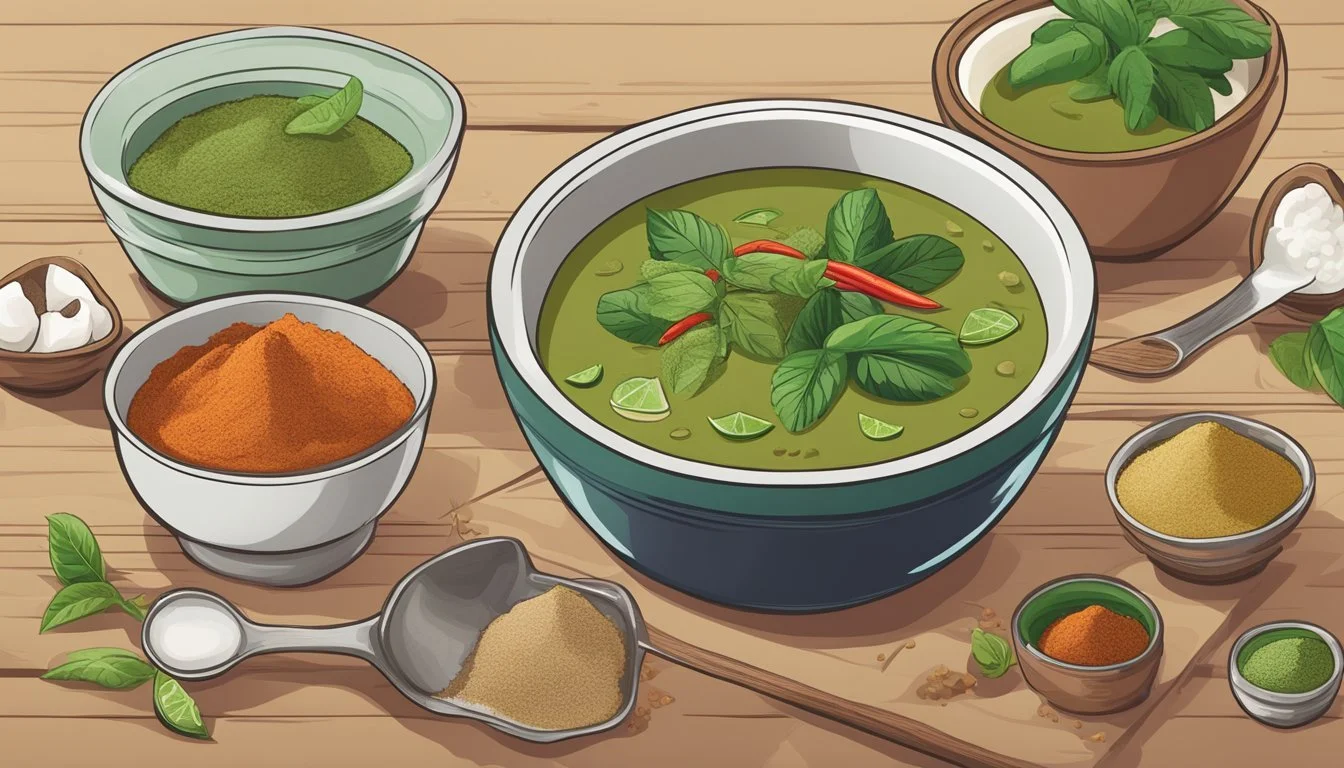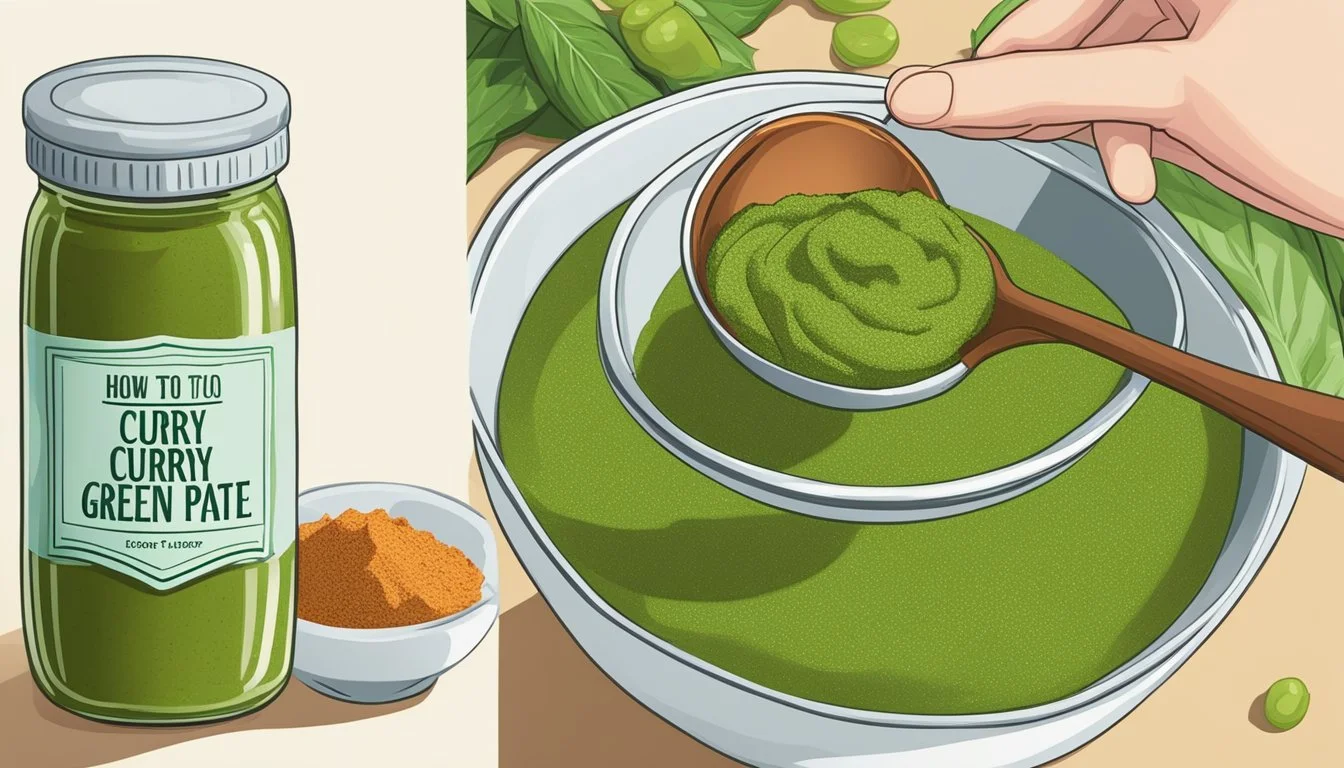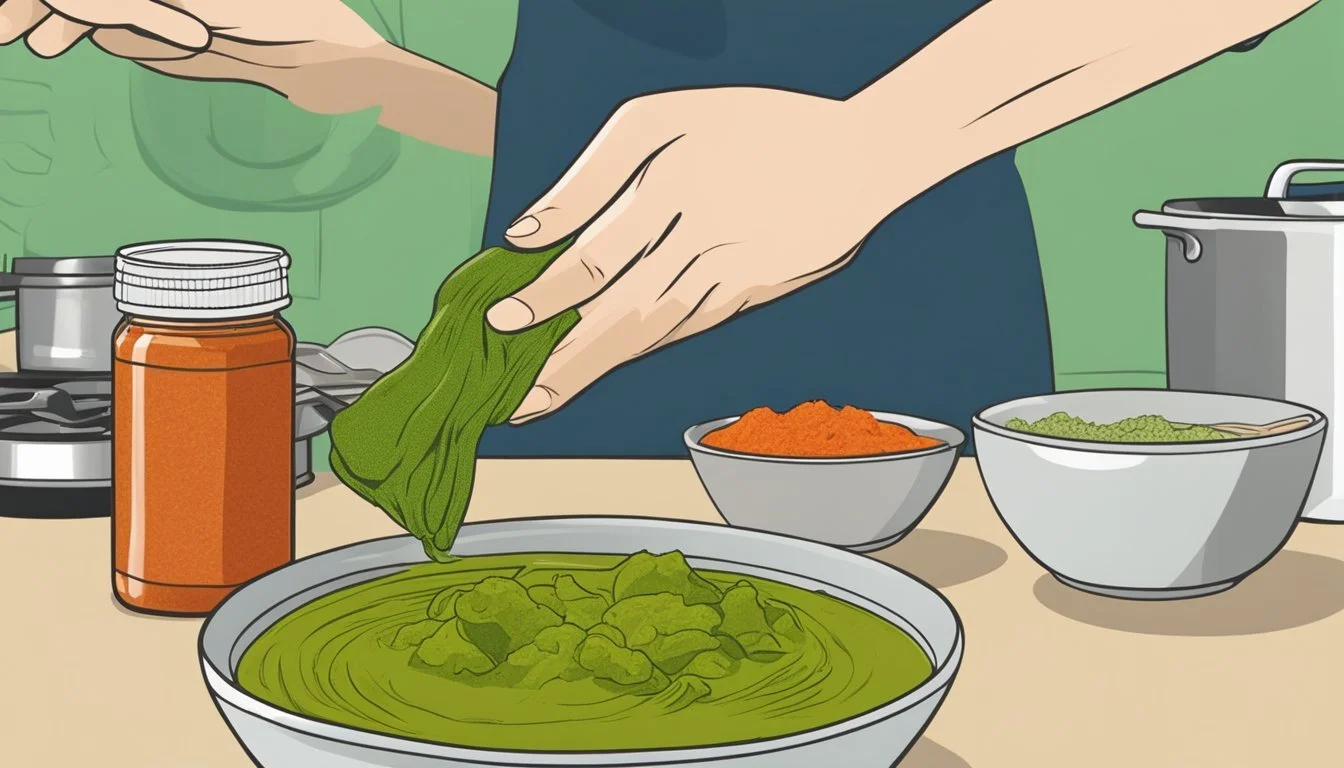How to Substitute Red Curry Paste for Green Curry Paste
A Simple Swap Guide
Substituting red curry paste for green curry paste is a common adjustment made in the kitchen, especially when a recipe calls for one type and a cook only has the other on hand. Although red and green curry pastes both originate from Thai cuisine and share several key ingredients such as garlic (What wine goes well with garlic?), lemongrass, and galangal, they bring distinct flavors and color profiles to dishes. Red curry paste, made with dried red chilies, offers a deeper and often spicier taste, while green curry paste, crafted from fresh green chilies, provides a brighter, herbaceous quality to the culinary creation.
When considering a substitute for green curry paste, one must account for the differences in heat level and the herbaceous notes that green curry imparts. Red curry paste can serve as an alternative, but there are considerations to ensure the end result maintains the intended flavor balance of the dish. The process involves understanding the fundamental components that make up these pastes and how their substitution affects the overall taste of a dish.
Navigating the intricacies of flavor profiles is an essential skill in adapting recipes to fit available ingredients without compromising on taste. The key lies in striking a balance between the spicy kick of red curry paste and the nuanced, verdant complexity found in its green counterpart. While the pastes are not identical, with careful adjustments and possibly the addition of supplementary herbs, they can be used interchangeably to delightful effect, thereby allowing for versatility and creativity in the kitchen.
Understanding Curry Pastes
Curry pastes are central to many Asian dishes, imparting deep flavors and defining the heat profile of the dish. They are as diverse as the regions they come from.
History and Origin of Curry Pastes
Curry pastes have roots in the culinary traditions of various countries, predominantly in South and Southeast Asia. Historical records suggest that these pastes have been used for centuries, evolving with trade and cultural exchanges. They facilitated the preservation of spices and aromatics, long before refrigeration was possible.
Varieties of Curry Pastes
Curry pastes vary widely, each offering a unique flavor:
Green Curry Paste: Originating from Thailand, contains green chilies and is milder than its red counterpart.
Red Curry Paste: Also Thai, but made with red chilies, typically has a more pungent flavor.
Other notable varieties include yellow curry paste, Massaman curry paste, and Panang curry paste, each with distinctive ingredients and heat levels.
Primary Ingredients of Curry Pastes
The core components of curry pastes tend to include:
Chilies: Green for green curry paste and red for red curry paste.
Aromatics: Such as lemongrass, garlic, and shallots.
Spices: Cumin, coriander, and sometimes peppercorns.
Herbs: Coriander roots and kaffir lime leaves are often vital.
Aromatic ingredients are finely ground, traditionally using a mortar and pestle, to create a concentrated paste that is both potent and flavorful.
Fundamentals of Curry Flavors
In substituting red curry paste for green curry paste, understanding their distinct flavor profiles and spice components is essential. Both curry pastes play pivotal roles in Thai cuisine with unique characteristics that define their use in cooking.
Green Curry Characteristics
Green curry, known as Gaeng Keow Wan in Thai, epitomizes the vibrancy of Southeast Asian flavors. Its characteristics are:
Color: A vibrant green, achieved through the use of fresh green chilies and ample amounts of cilantro (how long does cilantro last?), basil, and kaffir lime leaf.
Flavor Profile: A balance of sweet, spicy, and fresh flavors, often milder than its red counterpart.
Common Ingredients: Green chilies, shallot, lemongrass, garlic, galangal, cumin, coriander root, and kaffir lime rind.
Red Curry Characteristics
Red curry, or Gaeng Phet in Thai, is rich and robust. Its key characteristics include:
Color: A deep red, which comes from the red chilies used to create the paste.
Flavor Profile: A hearty and potent flavor with a combination of heat, depth, and complexity.
Common Ingredients: Red chilies, shallot, lemongrass, garlic, galangal, coriander seeds, cumin, and often shrimp (What wine goes well with shrimp?) paste for added umami.
Spice Profiles and Their Impact
Spices are the heart of any curry paste, each contributing to the overall flavor and aroma:
Green Curry spices often include cumin, coriander seeds, and white peppercorns, providing a subtle warmth.
Red Curry spices may include these as well but are augmented by hotter elements like dried red chilies for a more intense heat.
Aroma and Taste in Curry Pastes
The aroma and taste of a curry paste are influenced by its spice mixture and other aromatic ingredients:
Aromatics: Both curries leverage galangal, lemongrass, and garlic to build foundational scents.
Taste Balance: Green curry tends towards a fresher, sweet-and-spicy taste; red curry offers a bold, earthy, and savory experience.
Ingredient Profiles
When substituting red curry paste for green curry paste, one must understand the distinct flavor profiles and shared ingredients in each paste to achieve a similar taste and aroma.
Common Ingredients Across All Curry Pastes
Curry pastes share a foundation of aromatics and spices that provide a complex flavor base. These ingredients typically include:
Garlic: An essential component for its pungency and depth.
Lemongrass: Adds citrusy notes and freshness.
Ginger: Delivers a sharp, peppery bite.
Shrimp Paste: Offers a savory, umami depth (vegetarian substitutes include soy or miso paste).
Cilantro: Contributes a bright, slightly citrusy flavor.
Chilies: Bring heat and spice intensity to both pastes.
Unique Elements in Green Curry Paste
Green curry paste is characterized by its vibrant color and fresh taste, featuring:
Green Chilies: Usually milder than red, providing a gentler heat.
Lime: Its zest and leaves impart a pronounced citrusy aroma distinct to green curries.
Coriander Seeds: Along with cilantro, coriander seeds add a lemony, floral touch.
Unique Elements in Red Curry Paste
Red curry paste, on the other hand, is known for its richer and often spicier profile, including:
Red Chilies: Typically hotter, they contribute to the red paste's robust heat.
Cumin: Adds a warm, earthy note not as prevalent in green paste.
Turmeric: Imparts a golden color and a bitter, ginger-like flavor.
Substituting Ingredients for Allergies
Those with allergies can alter curry pastes by omitting or substituting ingredients:
Garlic Allergy: Asafoetida can be used as a substitute to mimic garlic's flavor.
Shrimp Paste Allergy: Fermented soybean paste or miso can replace shrimp paste to retain umami.
Chili Allergy: For a less spicy paste, bell peppers combined with spices like paprika can mimic the texture and flavor without the heat.
By understanding the ingredient profiles and how each element contributes to the overall taste, substitutions can be made effectively, allowing one to cater to dietary restrictions and personal flavor preferences while still maintaining the essence of the dish.
Substituting Curry Pastes
When modifying a recipe that calls for red curry paste with green curry paste, it’s essential to consider the flavor profile and intensity of the dish. The substitution process involves understanding when it is appropriate, what alternatives best match the original ingredient's taste, and the right quantity to use for balancing flavors.
When to Substitute Curry Pastes
Substitutions between red and green curry pastes are typically made when a recipe calls for one type, but a cook prefers the flavor profile or only has the other paste available. Red curry paste is generally more robust and less herbal than green curry paste, which is noted for its fresh, bright, and herby quality. Substitutes are applicable when these flavor differences can be accommodated in dishes such as curries, soups, or marinades.
How to Select a Substitute
To select an appropriate substitute for green curry paste, one should look for an alternative that provides a similar balance of heat, sweet, and savory notes. Green curry paste’s substitutes should contain comparable ingredients, such as green chilies, lemongrass, and galangal, to maintain the integrity of the dish's flavor profile.
Substitution Ratios and Adjustments
Same Type Paste Substitution: Green curry paste can be substituted with another Thai curry paste like yellow curry paste, using a 1:1 ratio. Adjustments might be necessary to achieve the desired flavor intensity.
Homemade Alternatives: If using a homemade paste, combine ingredients such as green chilies, shallots, garlic, lemongrass, and cilantro to mimic green paste’s flavor. Start with small amounts and adjust to taste.
Substitutes to Avoid
Avoid using curry powders or pastes with vastly different flavor profiles, such as Indian curry pastes or those with a strong tomato base, which can drastically alter the intended taste of a Thai-inspired dish. Harissa or chili pastes might be too overpowering and lack the necessary herbal notes present in green curry paste.
Creating Homemade Alternatives
When substituting red curry paste for green, one can opt for homemade versions to match the dish's intended flavor profile. Both pastes can be tailored to personal taste, and with some key ingredients and equipment, it's possible to recreate authentic Thai flavors.
Homemade Green Curry Paste
To make a homemade green curry paste, one typically combines fresh green chilies with aromatic ingredients such as lemongrass, galangal, garlic, shallots, and cilantro roots. They'll need to add spices like coriander and cumin seeds, which are first toasted to release their flavors. Everything is then blended with oil to form a smooth paste using a food processor or blender. For enhanced flavor, salt and black pepper can be included.
Ingredients:
Green chilies
Lemongrass
Galangal or ginger
Garlic cloves
Shallots
Coriander seeds (toasted)
Cumin seeds (toasted)
Oil (neutral flavor)
Salt
Equipment:
Food processor or blender
Homemade Red Curry Paste
Creating a red curry paste follows a similar method, but the main difference lies in the use of red chilies, which give the paste its distinctive color and heat. The addition of other elements like kaffir lime leaves and possibly paprika can adjust the paste's depth and flavor complexity. Once combined in a food processor or blender, the ingredients are blended with oil until achieving the right consistency.
Ingredients:
Red chilies
Lemongrass
Galangal or ginger
Garlic cloves
Shallots
Kaffir lime leaves
Oil (neutral flavor)
Salt
Tips for Making Curry Paste at Home
One should ensure that all ingredients are fresh for the best flavor. Also, chopping ingredients into small pieces can help in creating a more uniform paste when blended. They can adjust the chili amounts according to their heat preference. Using a food processor makes the process quicker, but a mortar and pestle can be used for a more traditional approach which might yield a paste with a slightly different texture.
Quick Tips:
Ensure fresh ingredients for better flavor
Chop ingredients finely before blending
Adjust chili to heat preference
Consider traditional methods for authenticity
Preserving Homemade Curry Pastes
Homemade curry pastes can be stored in an airtight container in the refrigerator for up to a week. For longer storage, they can portion the paste into ice cube trays, freeze, and then transfer to a freezer bag where it can be kept for several months. When ready to use, they can directly add the frozen curry paste cubes to their cooking.
Preservation Method:
Refrigerate in an airtight jar (up to 1 week)
Freeze in ice cube trays and then store in freezer bags (several months)
Adapting Recipes and Cooking Techniques
When substituting green curry paste for red curry paste in recipes, one must consider factors like heat level, recipe composition, and ingredient compatibility. Proper adjustments ensure the dish maintains its intended flavor profile and balance.
Adjusting Spiciness and Heat
green curry paste typically has a milder heat compared to its red counterpart. Cooks can increase the spiciness by adding extra chilies or a pinch of cayenne pepper. Conversely, to reduce heat, one should use less paste or incorporate coconut milk to temper the spiciness. Monitoring and adjusting the level of heat is crucial to meet personal taste preferences.
To increase heat: Add additional chilies or cayenne pepper.
To reduce heat: Use less curry paste or add coconut milk.
Culinary Uses Beyond Curries
Green curry paste's mild flavor makes it versatile for various dishes beyond traditional curries. One can use it as a seasoning in egg dishes or mix it into mayonnaise for a Thai-style sandwich spread. It's also suitable for marinating chicken or fish, provided the spiciness aligns with the desired taste.
Marinades: Use for chicken or fish.
Sauces: Blend into mayonnaise for sandwiches.
Pairing with Proteins and Vegetables
Proteins such as chicken and fish commonly pair with red curry paste, and these can still complement green curry paste when substituted. Onion, bell peppers, and bamboo shoots are vegetables that go well with the green variety, their flavors melding seamlessly with its herbal notes. Addition of fish sauce can further enhance these pairings, bringing a savory depth to the dish.
Proteins: Chicken and fish maintain compatibility.
Vegetables: Onion, bell peppers, and bamboo shoots match well.
Balancing Flavors When Substituting
While green curry paste can act as a substitute for red, one must balance the flavors to compensate for the variations in taste and aromatic profile. Ingredients like lemongrass, galangal, and kaffir lime leaves can be increased to mimic the complexity of red curry paste. These adjustments help retain the original dish's essence and can be achieved through careful tasting and tweaking during the cooking process.
Add more aromatics: Lemongrass, galangal, kaffir lime leaves.
Taste as you cook: Adjust seasonings to balance flavors.
Exploring Regional Curry Variations
Substituting red curry paste for green curry paste involves an understanding of the flavor profiles and ingredients typically used in regional curry variations. Each type of curry has distinct characteristics shaped by cultural influences and ingredient availability.
Thai Green, Red, and Yellow Curries
In Thailand, curries are a staple. Thai green curry, known for its aromatic and spicy flavors, features green chilis, basil, and lemongrass. Red curry paste includes red chilis, imparting a deeper heat and color. Yellow curry, milder and sweeter, incorporates turmeric and sometimes cumin, reminiscent of Indian flavors but milder than both green and red pastes.
Indian Curry Influences
Indian curries heavily influence Thai curries, bringing a depth of spices such as cumin, coriander, and turmeric. These are intensively blended into pastes that form the backbone of Indian curry dishes, setting a foundation that has inspired Thai curry variations, reflecting a balance between locally sourced ingredients and shared culinary traditions.
Fusion and Innovative Curry Applications
Fusion cuisine experiments by incorporating elements from multiple culinary traditions. Chefs might blend red curry paste into marinades or innovate with Thai yellow curry flavors in non-traditional dishes, such as curried soups in Western menus, showcasing the versatility and global appeal of curry pastes.
Curry Pastes in Vegan Cooking
Curry pastes are inherently plant-based and thus an excellent fit for vegan cooking. They add complexity to dishes relying on purely plant-derived ingredients. By substituting animal-based ingredients with rich pastes like Thai green curry paste, vegan dishes are infused with flavor profiles that are both robust and satisfying.
Sourcing and Storing Curry Pastes
Selecting high-quality curry pastes and storing them properly ensures maximum flavor and longevity. This section covers the intricacies of sourcing, storage, and understanding product labels.
Finding Quality Curry Pastes
When searching for Thai green curry paste or Thai red curry paste, it is important to explore Asian markets or specialty stores that offer authentic imported brands. Quality curry pastes often have a robust aroma and a balanced blend of spices and fresh ingredients such as lemongrass, galangal, and chilies. For alternatives, Panang or yellow curry pastes should show similar characteristics of freshness in their ingredients.
Optimal Storage Methods for Curry Pastes
After purchase, curry pastes should be transferred to airtight containers to maintain freshness. Refrigeration is ideal, as it can significantly extend the paste's usability. Homemade pastes may also be stored in the freezer, portioned in ice cube trays for convenience.
Shelf Life and Freshness
The shelf life of commercial curry pastes can vary, but they generally last for up to two years unopened. Once opened and refrigerated, they should ideally be used within six months for the best flavor profile. Homemade pastes have a shorter shelf life and should typically be consumed within a month when stored in the fridge.
Decoding Curry Paste Labels
Understanding labels is crucial for choosing the best product. Labels reveal the ingredients, origin, and sometimes the intensity of the curry paste. Consumers should look for pastes with a high concentration of herbs and spices and minimal preservatives. For specific dishes, labels might indicate if the paste is better suited for dishes like Thai yellow curry or if it's a versatile Panang paste.










